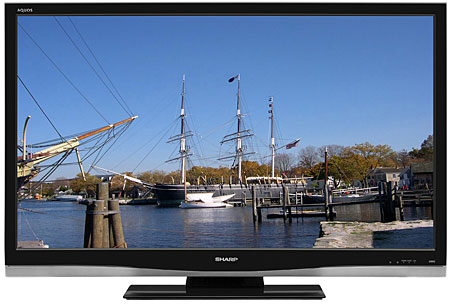Sharp AQUOS LC-52D64U 52" LCD HDTV

Sharp's latest sets are in the 64U series, coming in three sizes: 42, 46, 52 and 65-inches. The LC-52D64U ($3,499), like the others, has as its main selling point an ultra thin depth of just 3.75" (without stand). But there's more to the story here than a Slim-Fast diet.
Description
The Sharp's audio comes from a narrow perforated aluminum strip just below that. The sound (which I'll not cover further in this review) is surprisingly good considering the space it comes from—hardly serious home theater quality, but perfectly listenable for casual use.
There are onboard NTSC and ATSC tuners, but no CableCARD slot, a common omission in many new sets.
Inputs 5 and 6 include HDMI, and Input 6 also has separate L/R analog audio connections should they be needed—using the HDMI connection with a DVI source, for example.
The are additional inputs on the right side of the set, including component and HDMI, and a USB port on the same side panel for software updates. That's a real plus in a flat panel, particularly if it's wall-mounted. The set's controls are also just above this side panel.

HDMI CEC (Consumer Electronics Control) protocol allows compatible HDMI-connected equipment to be controlled through the set's remote control. Sharp calls its version of this feature AQUOS Link. I did not test it in this review.
Conspicuous by absence are PIP and/or POP. For some consumers this may be significant. For others, like me, it isn't.
The LC-52D64U does not operate at 120Hz. Currently only Sharp's F92 and D82 series offer this feature. And the set will not accept 24fps video. Sharp informs us that a running change enabling 24Hz compatibility is scheduled to start in units manufactured from December forward. No word on whether existing units will be updated.
Video Adjustments
There are eight AV modes: Standard, Movie, Game, PC, xvYCC, User, Dynamic Fixed, and Dynamic. While you can adjust each of these modes individually (except Dynamic Fixed), only User may be set separately for each input. I used Movie mode, with changes from the factory settings, for virtually all of my serious viewing and testing.
 Of the five Color Temperature settings, Low produced the most accurate results. Fortunately, it was quite close to the D6500 standard (see "Measurements.") Calibration could have improved it slightly, but doesn't provide adjustments for it. According to Sharp, however, field-adjustable calibration controls should begin to show up on its new models coming in 2008.
Of the five Color Temperature settings, Low produced the most accurate results. Fortunately, it was quite close to the D6500 standard (see "Measurements.") Calibration could have improved it slightly, but doesn't provide adjustments for it. According to Sharp, however, field-adjustable calibration controls should begin to show up on its new models coming in 2008.
As with many recent LCD sets, the Sharp lets you adjust the intensity of the panel's Cold Cathode Fluorescent Lamp (CCFL) backlight. There is also a feature called OPC, which senses the ambient light in the room and changes the backlight level automatically to compensate. I preferred to set the backlight manually and did not use the OPC.
I left most of the other special features off. Active Contrast did enhance the black level, but it sometimes degraded the image as well. Fine Motion did help reduce image blur with some program material, but it wasn't always a plus.
I/P Setting has two options: Fast and Slow. It's available only with progressive inputs, and I set it to Slow. The Digital Noise Reduction control (oddly, located under the Options menu, not Picture) can work well when you need it without seriously degrading the picture. But apart from checking its operation I left of Off for all my tests.
While there is no overscan control, the View Mode (aspect ratio) option Dot-by-Dot (not available with all inputs and resolutions) provides zero overscan. The zoom mode can enlarge letterboxed material to fill the screen with an undistorted, correctly proportioned picture. This includes standard definition letterbox programming over cable that's upconverted to 1080i by a cable box. Not all HD sets can enlarge such material properly, but rather display it only as a letterbox within a 4:3 area in the center of the screen.
The Sharp's remote is a good one. Its buttons are even backlit, though as usual some of the button functions are on the body of the remote—where they aren't backlit—and not on the buttons themselves. My only complaint is that the channel and volume control are located close together where you can easily hit CH up or down if you're reaching for the volume.
Piece by Piece
The Sharp turned in excellent result on most of my 480i-to-1080p deinterlacing/scaling tests, and the few that weren't quite excellent were still good. It properly deinterlaced 1080i HD to 1080p, including recognition of 3/2 pulldown. I have not yet tested any other video display that produced a better result on these tests.
The Sharp combined this excellent video processing with exceptional resolution to produce a compellingly crisp, detailed image. And provided the Sharpness control is set correctly and the program material is up to par, the image never looked overly sharp or enhanced. Again, I haven't yet tested another one-piece set that can do better in this regard.




























































